Motorcycle wheel lugs. Wheels for a walk-behind tractor are an important structural element.
When purchasing a walk-behind tractor for a farm, people focus on engine power and equipment performance. However, the performance of the unit is directly affected by the wheels for the walk-behind tractor. The running gear allows the unit to move on a personal plot.
Factory models are usually fitted with the right wheelset. But given the load on this structural element, the wheels often break. Accordingly, the farmer has to independently buy a failed part.
Criterias of choice
Any garden equipment is available in several variations. The chassis for a walk-behind tractor was no exception to this rule. If you look at the assortment of any store that sells spare parts for walk-behind tractors, you can see that there are three types of wheels:
- Pneumatic. Such products have a rubber tire and a camera.
- Rubber. Monolithic construction, which consists of a rim and durable rubber.
- Grousers. Metal elements aimed at increasing the cross-country ability of vehicles.
The complexity of the choice lies in determining the operating conditions of the equipment. For example, for processing a clay site or wet soil, it is recommended to use lugs. 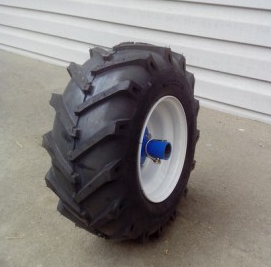
A walk-behind tractor equipped with conventional rubber wheels will not show good performance in difficult conditions. In addition, attention should be paid to the wheel radius and tread pattern.
Wheel sets belong to the category of quick-change equipment, so it makes sense to purchase two types of undercarriage. For example, lugs and pneumatic wheels. This will allow the equipment to work in different weather conditions.
What wheels can be put on a walk-behind tractor? Much depends on the intended use of the technology. If the unit is needed for planting and harvesting, you can stop on pneumatic wheels.
Such products are optimally suited for working on soft ground. The recommended radius is about 40 centimeters. At the same time, we recommend choosing wheels with a deep tread, which will increase maneuverability and patency.
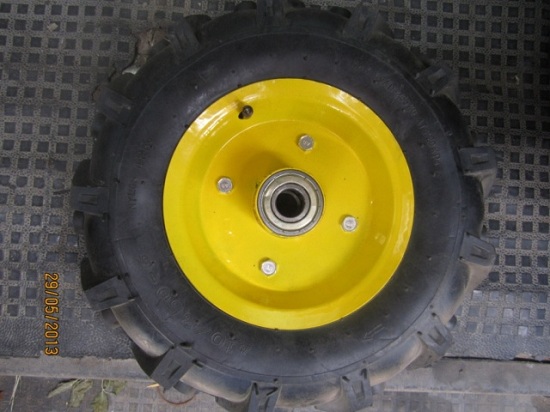
For primary processing of virgin soil and soil with a high content of stones, it is better to use cast wheels. They practically do not receive mechanical damage due to the lack of an internal chamber.
However, such elements have an increased weight, therefore they are installed on medium and heavy walk-behind tractors.
Grousers not only increase the throughput of equipment, but also increase its productivity. The teeth enter the soil, which creates additional force to move the unit in a given direction.

Such elements are used mainly for arable work on large plots of land. It is not advisable to use lugs on a small personal plot.
Do it yourself
Now let's talk about how to independently make wheels for a walk-behind tractor. Let us clarify right away that the creation of pneumatic and cast wheels at home is, in principle, impossible.
And why reinvent the wheel if you can equip garden equipment with tires from passenger car or motorcycle. You just need to install a suitable hub and you can get to work.
Another thing is when it comes to lugs. Such home-made wheels for a walk-behind tractor can really be made by yourself. Here is an elementary assembly diagram:
- We take old disks from the car. Please note that only the rim is needed. The diameter of the wheels depends on the power of the walk-behind tractor, given that the design will be all-metal, the weight will be considerable.
- We weld metal plates to the disks. The edges of the plates should touch the edge of the rim. This important element structures, so the plates are welded along the entire outer radius, it is possible to fix them with bolts to increase reliability.
- We weld the teeth to the metal plate. They can be made from a corner, after cutting it into pieces of the desired length. Please note that the distance between the teeth should not exceed 15-20 centimeters. Otherwise, the effectiveness of such wheels will be reduced to zero.
The arrival of small-scale mechanization in agriculture was marked by a significant simplification of the process of work characteristic of the area.
If earlier harrow and plow had to be done almost manually, using a minimum number of auxiliary tools, now it could be done using special technology. In this case, we are talking about walk-behind tractors - units that are full-fledged helpers in the garden and vegetable garden.
It is not surprising that the growth of such interest in this technique was associated with the use of various additional equipment of trailed and mounted type, which significantly expand the functionality of the walk-behind tractor.
However, the cost of all these equipments is quite high, taking into account the cost of the walk-behind tractor itself, so many craftsmen have adapted to make home-made versions of this or that technical tool. Moreover, home-made walk-behind tractors made on the basis of a wide variety of techniques began to appear.
To make it clearer, what is the principle of home-made manufacture of a walk-behind tractor and its additional components, it is necessary to consider in detail the device of the walk-behind tractor as a means of small mechanization. So, this unit includes several main working units:
- The main driving force, i.e. engine.
- Transmission.
- Chassis.
- Basic controls.
Engine
As the main driving force in the design of walk-behind tractors a standard internal combustion engine is used. Depending on the type and brand of walk-behind tractor, for example, the engine used may be different:
- Petrol 4-stroke engine. This engine is used for units belonging to the light and medium class of devices.
- Diesel 4-stroke engine. Motors of this kind are used on heavy and powerful walk-behind tractors designed to work on the most difficult surface areas.
For more information about the operation of a diesel walk-behind tractor, see the video:
Of course, 2-stroke motors are also found in the configuration, but they are used in fairly old models of walk-behind tractors, significantly inferior to 4-stroke ones in terms of power traction. However, most consumers get exactly 4-stroke petrol engines. Their device includes the following systems:
- Fuel supply system. Consists of a fuel tank, carburetor, air filter and fuel hose.
- A lubrication system that lubricates those parts that rub against each other.
- A starter that spins the crankshaft.
- A cooling system that removes heat from the engine cylinder block using airflow.
- An ignition system that produces a spark at a spark plug.
- The gas distribution system, which ensures the flow of the air-fuel mixture into the engine cylinder, and is also responsible for the exit of exhaust gases.
What matters is that the engine Sold with all major operating systems, which greatly facilitates the process of home-made manufacture of a walk-behind tractor.
Transmission
The main transmission function is the transmission of torque from the engine to the wheelbase, as well as regulation of speeds and change of movement of the unit. Its design includes several working units: gearbox, clutch, gearbox and differential (not available in all models).
Transmission can be of several types:
- Gear.
- Belt.
- Chain.
- Combined.
Mostly, the classic type of gear transmission is used on heavy walk-behind tractors , and it consists of bevel and cylindrical gears.
The remaining types of transmission are used in light and medium types of walk-behind tractors. At the same time, regardless of the type of transmission, the design contains a PTO - a power take-off shaft that transmits torque to the working units of the unit.
As for the clutch, it can be different:
- In the form of a V-belt transmission. The essence of the process is the clutch lever, which tightens or loosens the belt, which transmits, or stops the transmission of torque from the motor to the gearbox.
- Single or multi-plate dry or wet clutch.
- Conical clutch.
In most quality walk-behind tractors, the second type of clutch is used which is the most reliable.
Chassis
Chassis includes not only directly wheelbase, but also the frame structure to which these wheels are attached, and where the main working units of the walk-behind tractor are located.
In more modern models of a walk-behind tractor, a change in the distance between a pair of wheels is provided, which allows you to adjust the track size of the walk-behind tractor.
Today, there are two types of wheels - pneumatic and metal with lugs.
Basic controls
Walk-behind tractor control located on the handle of the unit, responsible for changing the speed and direction of movement of the device. The controls include:
- Levers, steering wheel and gear shifters.
- Clutch control.
- Lever or button to stop the engine.
- Gas supply, etc.
In the design of a walk-behind tractor missing seat for a person, therefore, the management itself is carried out by a person with his own hands.
Homemade catalog
I would like to start the analysis of homemade products from the direct making motoblocks with your own hands. We are not talking here that we will make the unit from scratch, because it is technically impossible for home conditions.
The main working units will be taken from other equipment, we just have to prepare a certain base on which it was possible to successfully connect all the organs of the walk-behind tractor.
I would like to talk about diesel walk-behind tractors on 4 wheels, the home-made products of which will be discussed later. At their core, these units are similar in appearance and in their technical data to full-fledged mini tractors.
To help farmers, companies produce a variety of special equipment to facilitate the work and maintenance of the farm. all about the device and characteristics of the Khryusha grain crusher.
Millions of people on our land are engaged in horticulture and agriculture. - Save your time, health and energy.
Those who have their own household should find out what the process of milking with a milking machine is like. By clicking on get acquainted with the milking machine AID 2.
The only difference is that the motoblocks do not have a differential lock, but otherwise they are very similar - the presence of a driver's seat, steering, and the presence of two pairs of wheels.
It is clear that the alteration will be based on addition to the existing walk-behind tractor several additional nodes- an additional frame for the second pair of wheels, the installation of a steering wheel and a chair, under which there should be a speed control, etc.
The finished version costs about 120 thousand rubles, so not everyone has the means to purchase it. Here it becomes useful homemade production which is gaining popularity every year.
To make a full-fledged 4-wheel walk-behind tractor, we need a fairly powerful base unit (Bison, Neva, etc.). In this case, we will consider a conversion from the Neva walk-behind tractor, because it is quite common in our country.
For greater convenience, you can purchase a ready-made conversion kit, which costs about 30 thousand rubles.
We conditionally divide the assembly process into several stages:
- First of all, we need take care of the frame. We are talking about an additional structure of the bearing type, under which the second pair of wheels will be located. To make the frame, we need pieces of pipe and metal corners.
- There are no special requirements for the parameters of the pipe, but it must be borne in mind that the load on these elements will be sufficient.
- The elements of the pipe must be cut with a grinder, and then fastened together with bolts. For better structural stability, a transverse steel beam can be welded.
- Also need weld a device for attaching attachments and trailed equipment to the frame. It can be mounted both in front and behind the unit.
- To mount the front pair of wheels, we need a metal pipe, the diameter of which must match the width of the front axle. Wheel hubs must be attached to the pipe.
- In the center, you need to drill a through-type hole, through which we fasten the structure to the front frame. Next, the gearbox and tie rods are installed. Then install the steering wheel.
- As wheels, you can use old ones from Soviet cars.
- We install the existing engine on the front of the structure. This is done so that the walk-behind tractor is more stable on the surface, because attachments or trailed equipment will be located behind it.
By the way, additional equipment will be connected with walk-behind tractor using a hitch(for a trailer) and a special bracket (for attachments).

Such do-it-yourself home-made products for a walk-behind tractor are quite reliable and practical in operation, because the whole structure turns out to be more monolithic, representing a complete device with a seat and a steering wheel. In terms of functionality, they are even comparable to mini tractors, which are much more expensive.
We will additionally consider homemade products for the Neva walk-behind tractor with our own hands, since it is so popular. In particular, you can make several options for additional equipment:
- Blade for motoblock.
- Okuchnik disk type, etc.
Dump
The blade is necessary not only for snow removal in winter, but also for clearing of various debris. For its manufacture, we need ordinary sheet metal, the thickness of which will be about 2 mm. Inside it, you need to weld 4 ribs of the same steel, but about 4 mm thick.
They need to drill holes through which the blade with rods will be fastened. The lower part of the structure is best sheathed with tin to prevent the blade from being buried in the ground.
Hiller
For its manufacture, we you will need a couple of ordinary metal lids from pots(enamelled, in this case, will not work). Their diameter should be about 500 mm. Next, we sharpen the edges of the covers on a grinding machine so that they better enter the soil.
Disc hillers need to be attached to a makeshift cart with wheels. They are made from ordinary bushings and pipes welded together.
Prefixes to motoblocks and motor cultivators, homemade products of which can be completely made independently, are of various types:
- Weeding equipment.
- Potato diggers and potato planters.
- Snow blowers, etc.
Trailers for walk-behind tractors and their homemade products are a fairly simple design, consisting of a conventional box with sides located on a wheelbase.
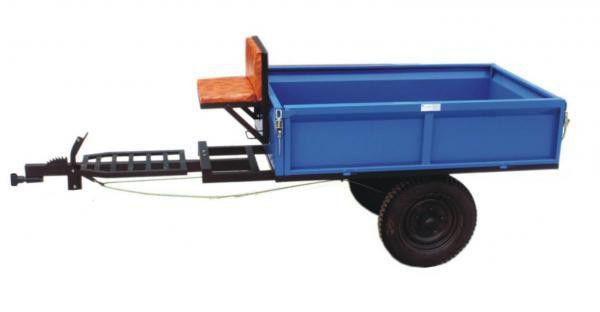
For self trailer manufacturing we will need:
- Professional pipe 40×25 mm and 25×25 mm. It is needed for the manufacture of the trolley hitch itself with a walk-behind tractor, as well as for the manufacture of sides - inside and under the trailer.
- For the body, we need to make a frame structure from a professional pipe 40 × 25 cm and 25 × 25 cm. The bottom of the body can be made from an ordinary piece of sheet metal. Pieces of the corrugated pipe must be welded to the bottom of the body in such a way that a lattice is obtained. On top of these edges, a full-fledged piece of professional pipe is welded around the entire perimeter.
- On the finished frame you need install profiled sheet, which will serve as boards. The height of each side is approximately 30 cm.
- The tailgate needs to be made folding. As latches, we use ordinary latches that need to be attached on both sides of the board. This board is attached to the bottom of the body with the help of ordinary hinges from the doors. On the same board, you can install reflectors that act as reflectors.
- wheels can be taken from Oka or Zhiguli cars - their diameter will be optimal.
- The bridge can also be taken from the old Zhiguli. The wheels are attached to it with a pair of bearings. You can fix the bridge to the frame using pieces of pipe, up to two on each side. One end of the pipe is welded to the bridge, and the other - to the body.
The feasibility of making a homemade trailer is quite understandable, because cost of all costs for homemade is about 4 thousand rubles, which is several times lower than the price of a finished trailer in the store.
The best homemade
Homemade products with an engine from a walk-behind tractor are also of some interest. Among them, the most interesting is snowmobile manufacturing. As a running gear, you can use a transport tape on which you need to attach snow hooks.
In addition, interesting are the options for manufacturing other various types of equipment from a walk-behind tractor:
- ATVs. By type of design, they resemble mini tractors, but they have wheels of a higher diameter. This is necessary so that the unit can pass through the most difficult terrain.
- Minitractor. We have already considered this design, which includes an additional part of the frame for the second pair of wheels, as well as steering wheels and a driver's seat.
Conclusion
Do-it-yourself homemade walk-behind tractors, the drawings of which can be found on the Internet, are the best way out for those who do not have the opportunity to spend extra money on the purchase of additional equipment.
Given that savings are significant, there are a lot of people who want to make such technical means with their own hands.
In most cases, before buying a walk-behind tractor, people pay special attention to the practical characteristics of the device, not being interested in the quality and features of the wheels. Such an approach can hardly be called competent, because the quality and duration of the operation of the equipment itself depend on these details.
Since the specified unit is a multifunctional device, different wheels are offered for the walk-behind tractor:
- pneumatic;
- traction wheels;
- solid rubber options;
- metal wheels with grousers.
To clearly understand the specifics of each type, you should consider their features in more detail.
These options are perfect for frequent arable work and digging up root crops. An important point: the width of the wheels should in no case be less than 20 cm, and the diameter - 40 cm. An aggressive tread pattern will be a huge plus.
Pneumatic products contribute to the incredible stability of the unit, but in case of damage they must be replaced. Often they are sold as wheels for Neva walk-behind tractors.
Traction
 These products have another name: "herringbone", and all thanks to their versatility and interesting tires. The increased grip width allows them to perform the task of both lugs and classic transport wheels.
These products have another name: "herringbone", and all thanks to their versatility and interesting tires. The increased grip width allows them to perform the task of both lugs and classic transport wheels.
Moreover, traction options are suitable for a cart and snow blower, and also help to cope with off-road. Durable high quality rubber is durable and long lasting.
Solid cast
For rocky ground, due to which many types of wheels deteriorate very quickly, solid products are ideal. Let them weigh a little more than the wheels discussed above, but they have no demolition.
These products have the most powerful tires for a walk-behind tractor, so they are bought for diesel types transformed into mini-tractors. For MTZ walk-behind tractors, solid ones are considered ideal options.
Metal with grouser
 Such wheels have a certain weight, therefore they are distinguished by additional power. Steel teeth "push" the unit forward and do not allow it to load even in the most clay soil.
Such wheels have a certain weight, therefore they are distinguished by additional power. Steel teeth "push" the unit forward and do not allow it to load even in the most clay soil.
Particular attention must be paid to the support front wheel, which has a considerable load. It contributes to the optimization of land work and increased endurance of the walk-behind tractor.
Trailer wheels have a similar classification and are selected according to the same principles. Do not forget that in the process of transporting heavy loads, low pressure is applied to the wheels of the walk-behind tractor itself, and high pressure is applied to the wheels of the cart (trailer). Therefore, in this case, you need to choose the most durable options.
How to make wheels for a walk-behind tractor with your own hands?
It must be understood that it is impossible to make wheels from scratch with your own hands. It is necessary to find the basis and only after that you can begin to form improved and useful devices.
As this very base, you should use the wheels from a motorcycle or from a car. You can only create a variant with a lug on your own, because in the event that wheel weights are not used so often, it makes no sense to purchase new expensive products. On our website you can find a specialized article where all the features of creating do-it-yourself lugs are considered in detail.
To expand the wheelbase, it is recommended to use extensions for the wheels of a walk-behind tractor, because it is necessary to correctly adapt the device to the individual needs of the farmer. Moreover, to expand the possibilities, it is possible to create iron twin wheels with a cavity inside to accommodate any weighting agent.
Yes, these objects can hardly be used for a walk-behind tractor trailer, but for the unit itself they will be very useful, because they can be created if a person does not have wheels from a motorcycle, but they are available from UAZ or Moskvich.
Advantages of twin wheels:
- reduction of slippage, and, as a result, an increase in the level of performance;
- the ability to quickly remove the wheels of the outer plan;
- ease of creation at home;
- maximum surface contact.
Twin wheels are gradually becoming more and more popular, because you can spend a little time on their own creation.
How to make twin wheels yourself?
Of particular interest to farmers was a simple and even a little rough, but effective way:
- First you need to find suitable wheels with tires;
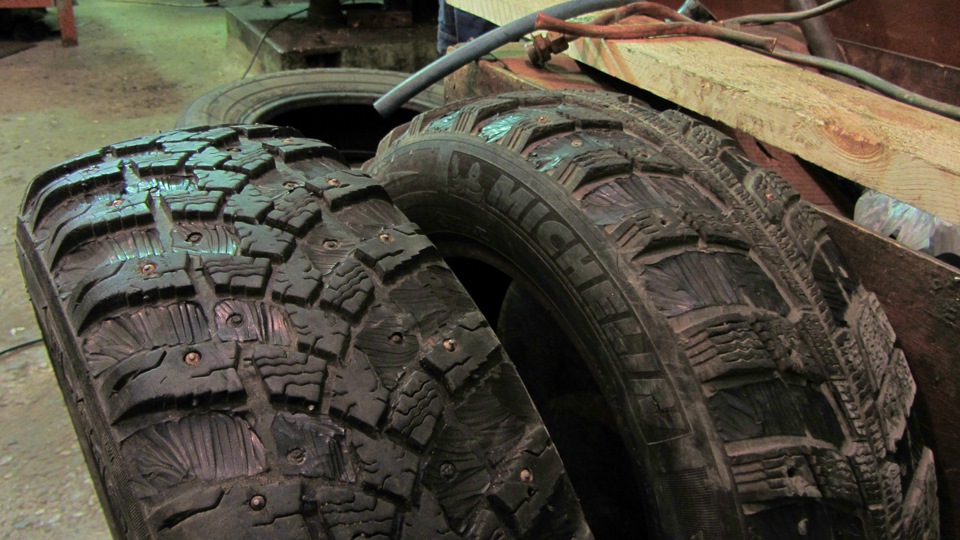
- Then it is desirable to cut small protectors on them;
- The next step is that people buy a 5x50mm strip of steel, weld 250mm squares and put them into the rim;
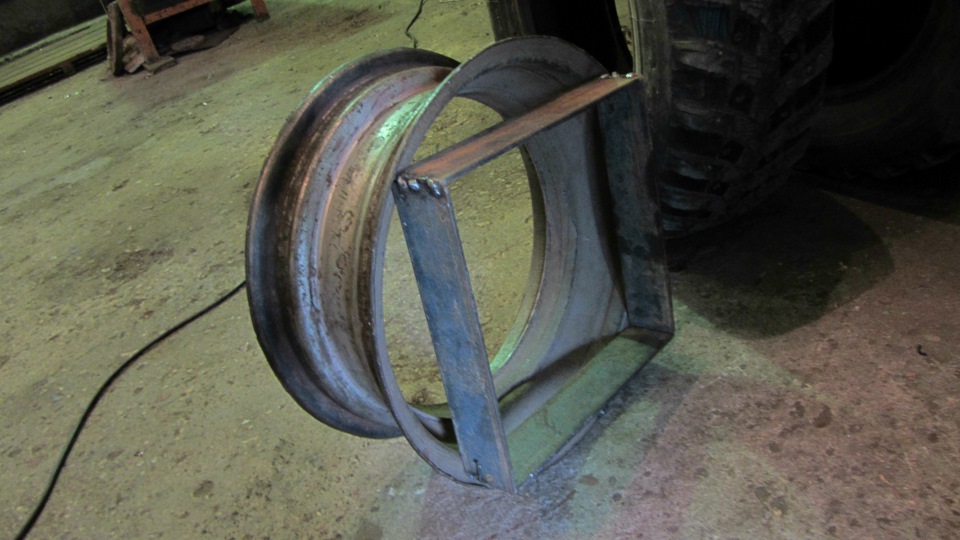
- After welding, the second wheel rim is set and objects that look like vases are obtained;
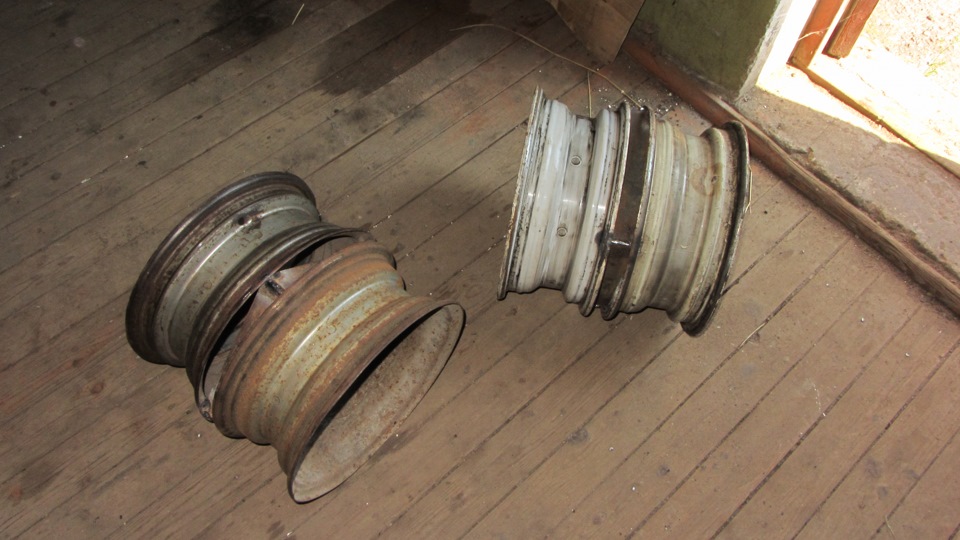
Such wonderful equipment as a walk-behind tractor in every household will be just a godsend. True, without a variety of attachments, and most importantly - wheels, it's just a pile of iron. Such equipment is on sale, of course, with wheels - how else to transport it. But most often for work in various conditions they are not suitable, but only suitable for transportation from place to place.
In order for the purchase to justify itself one hundred percent, it is necessary to choose the right wheels for the walk-behind tractor, and possibly more than one pair for more effective work in various conditions. Let's find out what wheels are, and in what case they are attached to the walk-behind tractor.
What wheels are best for a walk-behind tractor?
There are universal wheels for a walk-behind tractor, whose width is about 15 cm and a diameter of about 30 cm. They can be used to process simple areas, but they are not suitable for a wide range of garden work. It is better if plowing, weeding, sowing and harvesting are different. Especially when it comes to large areas, where it is agriculture that brings the main profit to the farmer.
For example, for plowing, planting and digging up root crops, fairly wide wheels will be required. But for hilling and removing weeds, they are rather narrow with a small tread, since their task is not to hush up the planting and not to compact the ground, but to leave it loose and remove weeds.
When purchasing a walk-behind tractor, you should focus on the size of its wheels and the distance between them before you start sowing, otherwise the processing will have to be done manually if the row spacing is not exactly observed.
Pneumatic wheels for walk-behind tractor
Many farmers believe that it is best to work the fields, and just drive on asphalt and dirt roads on rubber pneumatic wheels for a walk-behind tractor. But, unfortunately, they are not always appropriate, because it all depends on the type of work in which they are used, as well as on the soil on which they will be used.
Since the walk-behind tractor is used not only for loosening the soil, but for a variety of garden work, each of them will require its own wheels. So for plowing a plot of land, it is best to use wide wheels, since it is their tandem with plowshares and other attachments that will give an excellent result. The same wheels are also used for digging potatoes using a walk-behind tractor. During planting, this should be taken into account, leaving sufficiently large aisles, because the width of the wheel should be at least 20 cm.
Is it possible to use wheels from a car or motorcycle on a walk-behind tractor?
Craftsmen have long come up with an alternative to buying expensive wheels, borrowing them from old Zhiguli or a motorcycle with a sidecar rusting in the garage. This is undoubtedly good idea, but you will need to choose another hub for them so that it is compatible with a specific walk-behind tractor, because various models have different fasteners.
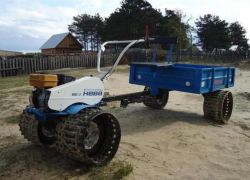
In order for the plowing of the earth to be deeper, for the soil to crumble, together with the plow, home-made or purchased lugs can be used as an additional harrow on the walk-behind tractor. Their very name suggests that they are needed for better traction with the soil, which the best pneumowheels with deep tread cannot give. The wider and higher the ribs on the iron wheels, the more efficient their work. They are suitable for both clay soils and loose chernozems.
Large metal wheels on a walk-behind tractor can be made independently using black sheet metal and welding machine, or you can go the easy way and take the old disks from the wheels on which the teeth are welded.
Starting to choose such a necessary agriculture small-scale mechanization techniques like a walk-behind tractor, first of all, attention is paid to its main technical features- power and performance - and very rarely the wheels of the unit are evaluated with due seriousness. Such an attitude to business is illiterate, since these parts of the mechanism are very important in the process of work, and the comfort and safety of equipment operation largely depends on their quality.
In the event that the wheels for the walk-behind tractor are of inadequate quality, it is likely that due to their breakdown, the tillage will not be completed on time or the load will not be delivered to the destination. That is why, when purchasing a walk-behind tractor, and even more so making a 4-wheel tractor out of it, you should be very careful with this part of the device.
It is worth remembering that for a number of walk-behind tractors you can not buy new wheels if necessary, but use wheels from a Zhiguli car or, as they are sometimes called, Zhiguli wheels.
Types of wheels
Like any equipment, wheels for walk-behind tractors have several types. It is necessary to understand them - this will help to choose and operate the unit correctly. Speaking about the types of wheels for a walk-behind tractor, it should be noted that there are only three of them:
- . pneumatic wheels with a chamber;
- . solid rubber wheels;
- . metal wheels with grousers.
Depending on the conditions under which the operation of the machine is planned, it is also determined which wheels are needed for it. So, rubber equipment is far from always able to provide a walk-behind tractor with good cross-country ability, and in difficult conditions it is required to shod the unit in metal with lugs. It is worth remembering that for heavy diesel walk-behind tractors, the wheels must be with an aggressive tread and have a significant diameter.
Features of choice
If the option of installing Zhiguli wheels is not considered, then it will be necessary to purchase equipment specially designed for walk-behind tractors, which must be chosen correctly. First you need to decide how the unit will function. When it is planned to carry out mainly arable work on the walk-behind tractor, attention should be paid to the first type of wheels. It is also ideal for digging up root crops.
The diameter of such wheels cannot be less than 40 cm, and the width - less than 20 cm. The tread pattern of these wheels for a walk-behind tractor should be aggressive. The same shoes are required for the unit during landing operations, when the stability of the machine is primarily important.
The disadvantage of such wheels is the possibility of damage to the chamber, which will lead to the failure of the wheel and the need to replace it. In the event that the wheels for the walk-behind tractor are bought second-hand, it is worth inspecting them with special care for the presence of sealed damage. Such wheels, as a rule, are included in the package for the Neva walk-behind tractor.
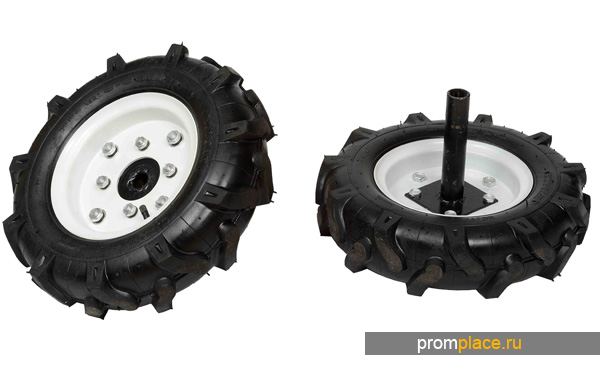
When you have to work with fairly rocky soil and the probability of damage to the wheels is high, the answer to the question of which wheels the walk-behind tractor needs is solid. They have practically no drift, but the weight is slightly higher than that of the previous species. It is good to equip diesel walk-behind tractors converted into mini-tractors on 4 wheels with such wheels. It is also good to put similar wheels on the MTZ walk-behind tractor.
Wheels for a walk-behind tractor trailer are selected, basically, according to the same principle. Moreover, it should be borne in mind that when transporting goods, the pressure on the wheels of a walk-behind tractor is lower than on the wheels of its trailer, which, for this reason, must have increased strength. Otherwise, there is a risk of being left with the load on the road due to a breakdown. When installing used wheels on a walk-behind tractor, such a danger is especially likely.
Grouser wheels are required when the walk-behind tractor needs additional power. The fact is that the steel teeth on the hooks firmly enter the ground, helping to move the unit forward. Such wheels are provided for all models, and the Neva walk-behind tractor is no exception.
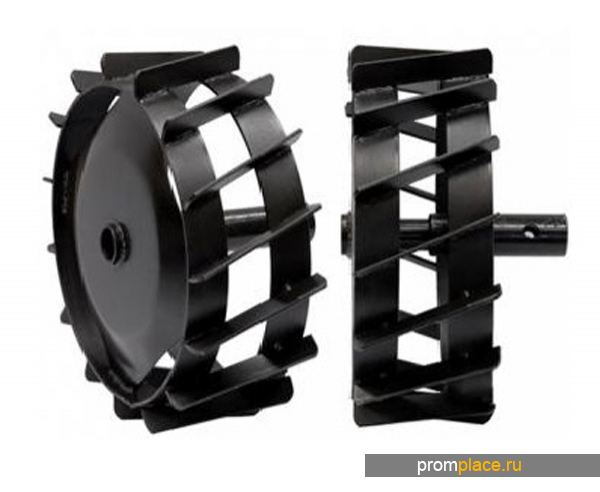
Separately, it is worth mentioning the support wheel for the walk-behind tractor, which, if possible, should be used to optimize labor during arable work.
Homemade
It makes no sense to make wheels for a walk-behind tractor with your own hands, but not when it comes to lugs. The fact is that if they are rarely used, then it makes no sense to purchase expensive factory samples.
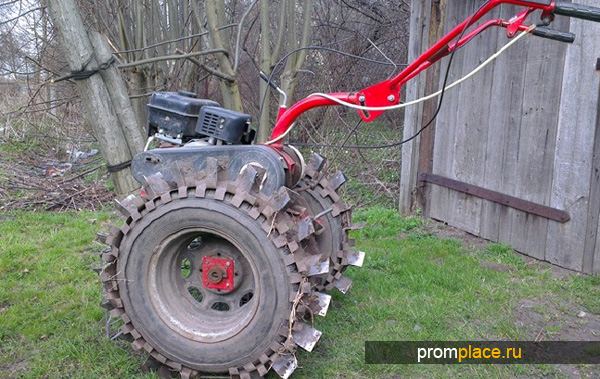
In order to make wheels with lugs on a walk-behind tractor as expected, you should follow the sequence of work and choose the right material of the desired strength. For the manufacture of lugs, you will need quite a bit:
- . old, without rubber wheels from a car;
- . steel squares of sufficient thickness;
- . steel corner;
- . bolts.
First, weld the prepared plates to the wheels so that their edges touch the rim. Then, with the help of bolts, they must be attached to it. Then, cutting the corner into pieces right size, they should be welded into teeth and then installed by attaching to the rim. The distance between the hooks must be at least 15cm. In addition, when deciding how to make such wheels yourself, it is worth remembering that machine disks can be replaced with ones cut from a spent gas cylinder.
When purchasing wheels for a walk-behind tractor, it is unacceptable to save on their quality by choosing the model with the lowest price. Only a well-equipped walk-behind tractor will become a faithful and reliable assistant for its owner and will not let him down at the most crucial moment. Given this, one should focus primarily on the quality, and not on the price of such an important part of the unit as the wheels, which are responsible for its ability to move.



